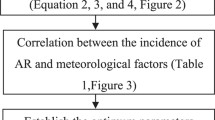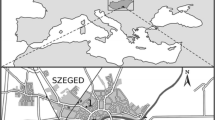Abstract
The frequency of bronchial asthma in Nairobi is related to meteorological parameters such as relative humidity, rainfall, dew point temperature, hours of sunshine and dry bulb temperature. Two seasons were taken for study: one cold season (May–August 1975) and one relatively warm season (December 1975–March 1976). It was found that significant correlations occurred at a lag of 2 or 3 days, but not at a lag of 4 or 5 days. Cold and wet weather during the cold season and heat of the day and dryness of the atmosphere during the warm season aggravate asthma in Nairobi.. The frequency of asthmatic attacks is about the same during the two seasons, but the intensity of suffering of a greater majority of patients is more in cold and wet weather than in warm and dry weather. 20–25% of the patients do not feel any relationship between weather and their asthmatic troubles. Nearly twice as many patients suffer from cough with the production of sputum in the cold season than in the warm season. About three times as many patients suffer from bronchospasm in the cold season than in the warm season. Severe asthmatic attacks occur almost equally in both the seasons.
Similar content being viewed by others
References
DERRICK, E. H. (1965): The seasonal variation of asthma in Brisbane: its relation to temperature and humidity. Int. J. Biometeor., 9: 239–251.
DERRICK, E. H. (1966): The annual variation of asthma in Brisbane: its relation to the weather. Int. J. Biometeor., 10: 91–99.
DERRICK, E. H. (1972): Asthma and the Brisbane climate. Aust. N.Z.J. Med., 3: 235–246.
MAUNSELL, K. (1952): Quantitative aspects of allergy to house-dust. First Intern. Congr. for Allergy, A. S. Grumbach, (ed.), Karger, Basel, 306–314.
REES, P. H., GITOHO, F., MITCHELL, H. S. and REES, C. (1974): Some aspects of the aetiology of asthma in Nairobi with special reference to parasites and the house dust mite. E. Afr. med. J., 51: 729–733.
SPECHT, R. L., BROUWER, Y. M. and DERRICK, E. H. (1975): Seasonal waves of asthma — a possible botanical cause. Int. J. Biometer., 19: 28–36.
STORM VAN LEEUWEN, W., BIEN, Z. and VAREKAMP, H. (1925): Über die Bedeutung von Klimaallergenen für die Ätiologie allergischer Krankheiten. Z. Immunitätsforsch., 43: 490–525.
TROMP, S. W. (1963): Medical Biometeorology. Elsevier Pub. Comp., Amsterdam, 464–476.
Author information
Authors and Affiliations
Rights and permissions
About this article
Cite this article
Fleischer, S.L.M., Asnani, G.C. The influence of weather on asthma in Nairobi. Int J Biometeorol 22, 263–270 (1978). https://doi.org/10.1007/BF01552807
Received:
Issue Date:
DOI: https://doi.org/10.1007/BF01552807




